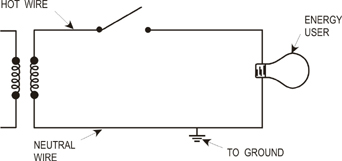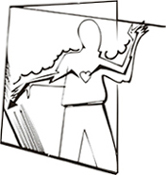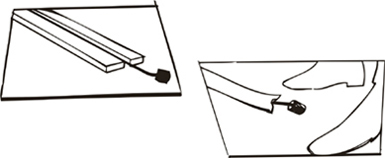The Dangers Of Electricity
You use electricity every day of your life, so it is easy to take it for granted. Yet electricity is a major cause of injury on the job.A jolt of electricity can hurt you, burn you, knock you unconscious, or kill you. How much electricity will kill you? It's hard to say. An amount that might just give you a slight shock one time might kill you another time. Damp skin, wet ground, metal-tipped shoes, or a two-handed grip can make even a relatively small amount of electricity fatal. Current as low as 5 milliamps can be dangerous in some cases.
The main danger of electricity is that the voltage clamps your heart muscle and causes a very irregular movement. As a result, your heart stops pumping, blood circulation stops, and you stop breathing. If CPR is started immediately, it may be able to revive someone who has stopped breathing because of an electric shock. Electric shock can also cause other muscle spasms. If someone touches a live electrical line, a muscle spasm of the hands may make it impossible to let go of the wire. High voltage can cause burns.
If you are on a ladder or a scaffold, a shock can cause you to fall.
Another danger is that electricity can start a fire. Electrical fires often start out of sight and can become dangerous before they are even noticed.
Electricity is safe only if you use all the safeguards built into the system, as well as common-sense safe working practices. Can you answer these questions?
This article will give you answers to these questions.

Electrical Circuits
To work safely with electricity, you should know a few things about it. Think of electricity flowing in a wire circuit like water flowing in a pipe. Electricity is safe as long as it flows in the circuit designed for it.In a proper circuit, electricity flows from the power source through a conductor to the energy-using device (motor, lamp, heater) and back to the power source (Figure 1). In a single-phase circuit, one wire connected to the switch for the energy-user is the hot wire (Figure 1). The other wire is the neutral wire (Figure 1). The neutral wire is always grounded. That is, it is attached to something that would conduct electricity to the ground where it would be neutralized. The neutral wire is sometimes mistakenly called the ground wire because it is grounded.
Some materials are good conductors. That is, they allow electricity to move through them easily. Silver, copper, aluminum, most other metals, and water are good conductors.
Some materials are good insulators. They offer high resistance and do not allow electricity to move easily through them. Rubber, glass, most plastics, and dry air are good insulators.
Other materials are in between - neither good conductors nor good insulators.
The difference between conductors and insulators makes it possible to use electricity safely by keeping it contained within a circuit. Copper is commonly used for wiring because it is a good conductor at a reasonable price. The wire is protected with insulation that keeps the electricity from escaping to anything else - such as people.

Short Circuits
Trouble starts when electricity escapes from the circuit designed for it. It might happen because the insulation is damaged, perhaps because excessive electric current causes high heat in the conductor and burns through the insulation. It might happen because damaged wires allow the electricity to bypass the energy-using device such as the lamp in Figure 2.
Since the bypass has less resistance than the path through the lamp, more current surges through the short circuit. The high current heats up the conductor and can burn through the insulation. This type of short circuit can cause a fire, explosion, or other damage to people or equipment.

Electricity always takes the path of least resistance. It flows through the best conductor. Unfortunately, the human body is a good conductor, since it is mostly water. If a human body is in contact with the ground, electricity can easily flow through the body to the ground. If it flows through your heart on its path to the ground, your heart may stop (Figure 4). When you work with electricity, your basic safety practice is to keep from being a conductor to ground.
On DC circuits, you must touch both wires to be shocked. However, automotive DC circuits are grounded by being connected to the auto frame and engine. Touching the hot wire and the vehicle frame is the same as touching both wires.

Stored Electricity
Electricity isn't always moving through wires. It can also be stored in various ways. A battery is a familiar way of storing electricity in a DC circuit. In AC motors and other electrical equipment, a capacitor is a small component that stores electricity.Even when the equipment is completely disconnected from any power source, a capacitor may hold enough electricity to give you a shock if you touch it. You have to know how to discharge the stored electricity in the capacitor by letting it escape to ground.
Common Voltages
In general, the higher the voltage in a given circuit, the higher the current, and therefore the more dangerous the shock. Human skin usually resists anything under 48 volts, so you probably won't feel a voltage under this amount.Most power used in homes and small businesses is 110 to 120 volts (V). However, almost every house has a 220-volt circuit for large appliances such as the washer and dryer. On the job, you may encounter 208V, 220V, 230V, 440V, or 460V. Anything over 600V is considered high voltage and requires special protection devices.
Wall Plugs
The wall outlet and plugs for 110V or 120V can be one of five kinds:1. Old style 2-prong plug. It has no safety feature and it is obsolete. It is seldom seen except on inexpensive extension cords.
2. Polarized 2-prong plug. One flat prong is wider than the other. It can be plugged in only one way so that the neutral wire of the circuit is connected to the neutral wire of the equipment and the hot wire of the circuit to the hot wire of the equipment. There is less chance of a short and fewer electrical problems for the equipment. The polarized plug provides some protection from electrical shock, but not as much as the 3-prong grounded plug.
3. Grounded 3-prong plug. A round prong is grounded to the frame of the equipment. If there is a short, current will pass through the grounded plug - not through you. This ground wire is separate from the grounded neutral wire of the circuit. A 3-prong plug is usually used with rotating equipment such as a drill motor.
4. Ground-fault circuit interrupter (GFCI or GFI). Electrical outlets exposed to the weather or to other wet conditions (such as bathrooms) must be GFCI outlets. The GFCI monitors the current in the two wires of the circuit. These two currents should be equal (within a certain tolerance). If they are not equal, there is a short and the GFCI disconnects the circuit. A GFCI outlet has a reset button on it.
5. 220V plug. The wall outlet for a 220V circuit has a special design to accept a plug with three flat prongs (or some other special pattern) so that it cannot be confused with a 110-volt circuit.
Avoid Electrical Dangers
There are four main kinds of danger from electricity:1. Shock (ranging from a mild jolt to death)
2. Fire
3. Burns (which may spread beyond the surface burn that shows)
4. Injury (from machinery started up while you work on it; from a shock that causes you to fall into moving equipment or knocks you off a ladder or scaffold)
Fortunately, by following safety rules, you can avoid most electrical accidents.

Protect Yourself
Your first line of defense against electricity is to keep yourself from being a conductor.
Keep It Turned Off
Never assume that a circuit is turned off. Of course you will turn off the power to any equipment you have to service, but you must make sure it really is off and that it stays off. Too many accidents have happened because one worker turned a switch on after another worker had turned it off for good reason. There are two dangers:1. Electricity can cause a shock.
2. Equipment started when you aren't expecting it can injure or kill.
If you want it off, make sure it stays off.
For equipment on an electric cord, unplug it before you work on it, and put a warning tag on the plug telling others that you are working on the equipment.

your own padlock. Even if a switch is already locked out, put your own padlock on it. Tag the lock with your name, location, and date.
Even if you have turned off the main power or disconnect, take a voltage reading on the lines to be sure they are dead (Figure 7). If the switch is not properly wired, there could be power in the circuit even though the switch is in the off position.
Make sure that any capacitor is discharged safely before you begin work. If you do not know how to do this, get someone to show you.
Remove locks and tags as soon as you are done working. If they are left on longer than needed, other workers won't take them seriously in the future. Make sure you have your own lock and tags.

Keep Equipment Safe
Don't use faulty equipment. If anything electrical - from a small hand tool to a major piece of equipment - is damaged in some way, it is not safe. Get it checked or replaced.Use Safety Features
Don't try to get around safety features. Safety features are there for a reason.This is an outlet that breaks the circuit if moisture or anything else causes a short circuit.
Safety Tips
What To Do In Case Of Electrical Shock
Every emergency is different. The general advice that follows may not fit every situation exactly. You must use your good judgment when you help someone who received an electric shock.Don't become a victim yourself. Live electric current can flow from one body to another. Don't touch someone who is still in contact with electricity.
If the victim is in contact with current, cut off the contact:
Once the victim is free of the current, check for pulse, heart beat, breathing, or an obstruction in the throat. If the victim is not breathing, use CPR if you are trained. Get help by calling 911 (or your local emergency number) or by having someone else call.
Loosen the victim's clothing to allow free breathing. Keep the victim lying down or resting. The heart may be very weak, and sudden activity could cause heart failure. Do not give the victim alcohol or medications. Keep the victim from getting too hot or too cold. Don't leave the victim until medical help arrives. There could be a relapse.
Your first responsibility is to keep from making yourself or someone else a victim of electricity. Keep a healthy fear of electricity and never just assume that conditions are safe. You may not have a second chance to guess right.
Excerpted and reprinted from Basics Of Electricity by Leo A. Meyer, one of the books in the Indoor Environment Technician's Library series published by LAMA Books. For over 30 years, Meyer has been writing and publishing training materials for the HVAC industry. His books cover a wide range of topics, including heating and cooling, indoor air quality, sheet metal work, electricity basics, safety, and others. For more information, visit www.lamabooks.com.
Publication date: 05/30/2005

Report Abusive Comment